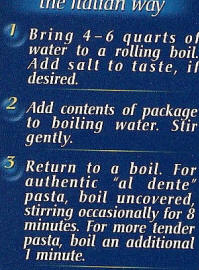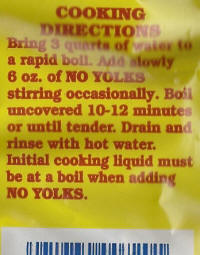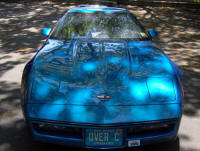RIKLBLOG
|
| Tomorrow |
| 09 Sept. 2008 |
| Yesterday |
| Index |
| Eventide |
| SETI League |
| PriUPS Project |
| Bonus! |
| Contact |


Pasta Power
There are plenty of big ways to save energy. The reviled yet fundamentally sound injunction to keep your tires properly inflated is one of them. So are any number of driving hints, such as keeping to the speed limit, not using your brakes, timing traffic lights, and the like. But you're already employing these, and getting much better mileage as a result. I'm sure you've also switched to more efficient compact fluorescent lamps from the evil incandescents, too. After turning your thermostat down in winter and up in summer, what's left?
How about a revolution in how you cook your pasta?
The Pasta Problem
You eat pasta. Pretty much everyone else does, too. Which, in the United States, equates to a good fraction of 300 million pasta eaters. You may also cook pasta, although there are fewer of "you," since many cooks prepare food for more than one person. If a pasta portion typically feeds three people, that would reduce the cooks to only 100 million. (I am not among them, having barely gotten down the art of tea. Although I have broadened my horizons and now am capable of preparing not only tea with lemon, but also tea with milk. That doesn't stop me from theorizing, as you will find out at painful length hereafter.)
How is pasta cooked?
-
Boil water.
-
Throw in pasta, cook till done.
Interview With Subject 2
Q: How do you cook pasta?
A: I boil water, then throw in the pasta, and wait until
it's done.
(During this interview, Subject 1, whom I had previously interviewed, had to be almost forcibly silenced, as she knew what I was getting at. I ultimately succeeded with difficulty in maintaining the scientific objectivity of the interview.)
Q: Why don't you throw the pasta in the
cold water first and then cook the ensemble?
A: Because I've always boiled the water first. That's
how it's always been done.
Q: Why?
A: Because cooking the spaghetti in cold water makes it
mushy.
Q: Why?
A: I don't know.
Q: Have you ever tried it?
A: No.
I should add that Subject 2 averred that she had been cooking spaghetti since she was "one year old." Rather than casting doubt on her veracity, I chose to consider this a metaphor for "a long time, and lots of spaghetti."
The Hypothesis and the Myth
As Mark Twain said, "It ain't the things you don't know that hurt you, it's the things you know that ain't so." As a non-cook, who has little living memory of ever cooking pasta, I don't have a dogmatic notion of the necessity for pre-boiling. Whether it's so or ain't so remains to be determined. I have formulated a hypothesis. It is, simply, that
1: There is no noticeable effect on the
quality of the cooked pasta whether it is cooked by throwing it into
boiling water or if it is thrown into cold water and then boiled.
2: It requires less energy to cook the pasta if it is
thrown into cold water and then cooked.
 |
This hypothesis is in direct contradiction to directions on two random pasta packages, one of which even emphasizes the need for pre-boiling. Science? Or dogma? Clearly, the pasta will be cooked faster if started earlier, i.e., in the cold water. Will it otherwise suffer? |
 |
Enough speculation. I have recruited a "panel of experts" to test my hypothesis. The requirements for joining the panel were fairly simple: Each candidate was first given the mirror test: If it fogged, he (that is to say "she") was considered a prime candidate. Further qualification was solicited with the more difficult "can you tell time" and "can you boil water." As expert panels go, this one was less of a challenge than most.
The Experimental Protocol
Fortunately no special equipment had to be provided by the principle investigator, since the experimental apparatus is almost always found inside the home. Each panelist was instructed to:
- Locate a package of pasta. "Shopping," if required, could be delegated to a third party as desired.
- Divide in half the package of pasta.
- Cook the first half following the directions on the package.
- Using the same stove settings, quantity of water, cooking utensils, etc., cook the second half instead by putting the pasta in the water immediately before turning on the stove. Stop cooking when the pasta reached the same consistency as it did in step 3.
- Report how long, to the nearest 10 seconds, process 3 required vs. process 4.
- Report whether, in your opinion, if and how the finished pasta prepared in step 4 differed in quality, taste, appearance, etc., from that prepared in step 3.
The Results
Where are they? Remember, this is Science! First hypothesize, then test. I don't come to conclusions and then make the evidence fit them. At least not in this specific blogitem.
I will report on my expert panel's results as soon as they are in. And you are invited to join! If you want to try the experiment, please do! Send an email with the following experimental results:
| Panelist | Brand of Pasta | Type of Pasta | Cooking Time Following Directions |
Cooking Time Starting Cold |
Subjective Pasta Quality Report |
When the experiment is complete, I will name the small town the can be powered by the energy saved by cooking pasta using the RIKLBlog protocol.
Feeding The Cat
One of the folk items I have discovered about cooking pasta is that one way to tell that it is "done" is by throwing a piece at the ceiling to see if it will stick. Oddly, this was related by one of the few human males with whom I discussed this issue, and it immediately raised two questions. The first was whether this is a valid method of making the ceiling more interesting, e.g., by giving it an attractive "stucco" (more literally, stuck-o) look instead of the usual ceiling tile appearance. Best try this at work, especially if you have the typical cafeteria with microwave and hung ceiling.
Even more interesting, though, was the notion that this might be the perfect (i.e., almost free) way to feed the cat while one is away. Would pasta stuck to the ceiling be deposited on the floor in a "timed release" fashion? It seems to me that there are enough chaotic processes involved in the initial sticking that it might just work. (Of course, I have no idea if cats can, should, or will eat pasta.)
| Special Advertising Section | ||
 |
Please buy this lovely blue
Corvette ZR1!
(The Mitsubishi has been sold, and the buyer (from South Dakota!) has it safely home.) |
|
NP: "Does It Really Happen" - Yes
| © 2008 |
| Richard Factor |